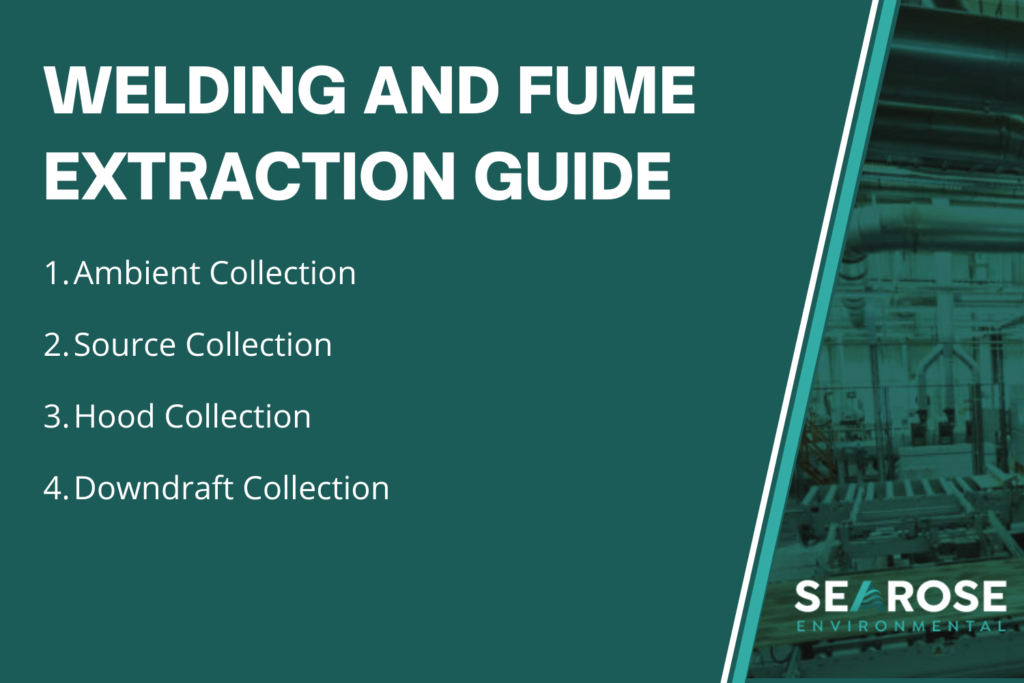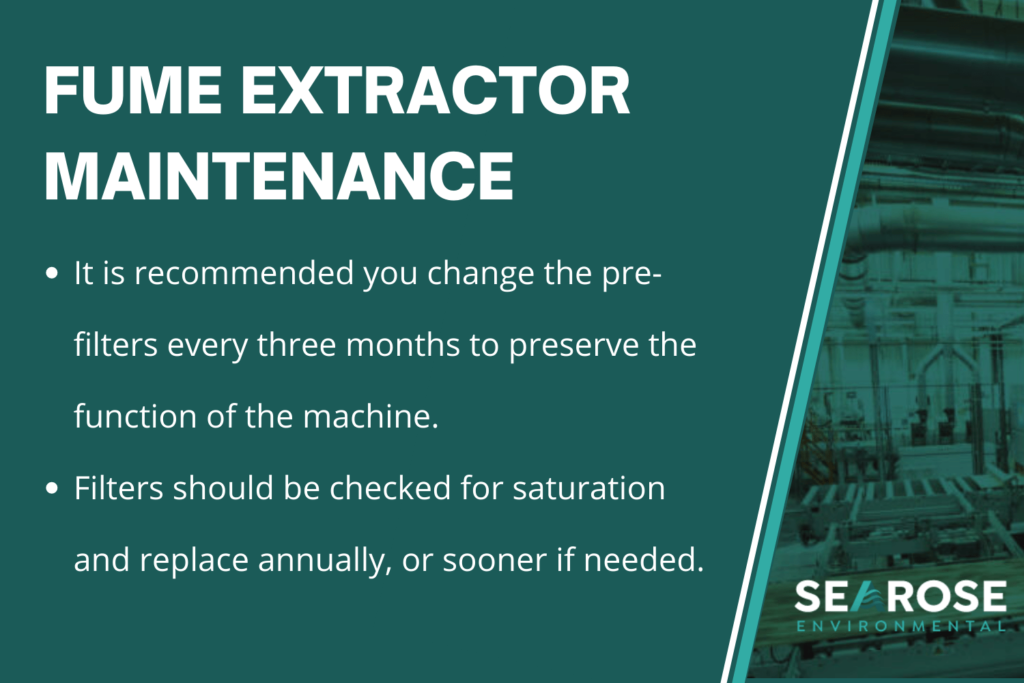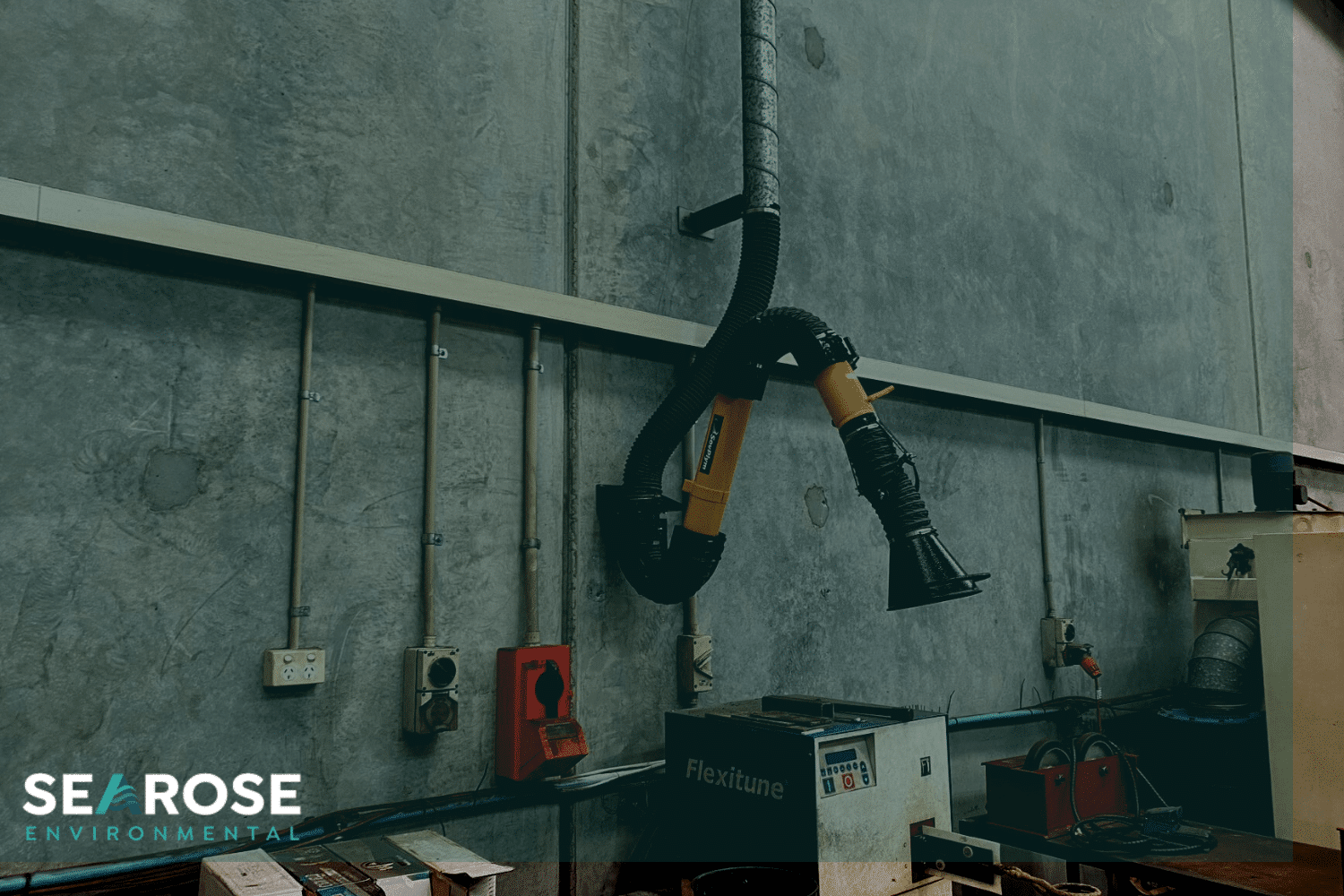There are several industrial activities that produce harmful fumes in the process. Welding, for example, produces both particulate and gaseous matter. Depending on the material, some of the by-products of welding are harmful to human health. In these instances, it is essential to have not only proper ventilation, but a functioning fume extraction system to keep workers safe. So, what is fume extraction? And what is a fume extractor? Within this article, the experts at Searose Environmental will cover the basics of fume extraction and its benefits to providing a safe and healthy workplace.
What is a Fume Extractor and How Does It Work?
A fume extractor is a system that utilizes a fan providing negative draft which pulls both hazardous fumes and dust particles away from an area through a filtration system. Modern fume extractors have multi-layered filter systems to properly clarify the air in the targeted workspace.
By combining a powerful fan with meticulous filtration, cleaner air is provided around the worker to complete the chosen industrial process. Welding, grinding, sanding, and spraying all produce fumes that require this sort of extraction to protect not only individuals, but also the equipment and the environment.

Types of Fume Extractors
Fume extraction can take many shapes and forms, as there are several types of extraction systems used for different industrial processes.
1. Downdraft Tables
Downdraft tables are a simple yet effective fume extraction system that draw in fumes and particles at the source. Fumes are drawn down from where they are released and into a channel which passes through a grid into exhaust ducting. Downdraft extraction prevents the fumes from rising and entering into the worker’s immediate breathing zone. Downdraft tables are suitable for smaller work zones, as they provide complete zonal coverage without impairing vision, but can be expensive and impractical when built into larger tables.
2. Mobile Fume Extraction Systems
These systems have wheels installed and can be portable around a workspace as needed to draw in fumes without needing to be fixed to one point. Mobile systems come in several sizes to accommodate larger projects and come with either disposable or self-cleaning filtration systems.
3. Mounted Fume Extractors
Mounted systems are fixed in place, often where frequent work requiring fume extraction takes place. Typically mounted to a wall to save floorspace, these systems often connect to overheard ducting which ensures hazardous fumes and particles are kept well away from workers.
Disposable vs Self-Cleaning Units
A large component of understanding ‘what is fume extraction?’ is knowing the differences in the filtration systems. There are different types of filters, and each are suitable for protection against different particles. It is important you research the nature of the fumes and particles being released from the material before selecting the most applicable filter or your needs.
The other debate about filters is whether to use disposable or self-cleaning filtration units. Disposable units are systems that after they reach capacity, they are discarded and not used again. On the other hand, self-cleaning filters may be used multiple times, as the particles can be safely removed from the filter.

There are benefits to both systems. Self-cleaning systems, whilst initially more expensive, operators will save on new filters, as they can be used multiple times. Disposable filtration systems are cheaper yet require constant replacing. It is about selecting the system that most fits your needs, or how often you use the extraction system.
How Does a Welding Fume Extractor Work?
Welding is one industrial process that creates both hazardous fumes and particles. Welding rods contain a high level of manganese, which is used to help with bonding. Inhalation of excessive manganese is toxic and leads to severe respiratory problems. Prolonged exposure to manganese toxins will enter the bloodstream and damage the kidneys amongst other issues.
So, how does a welding fume extractor work? Well, it needs to be able to remove the fumes emitted from welding at the source. To do this, the extractor needs to be installed nearest to the welding bench to help remove metal particles and sparks from the air quickly from the materials being welded. Sparks that captured in the welding process are filtered away from any dust via gravity filters and spark arresters that are fixed in the extractor.
If this is not possible, the next best method is the installation of an extraction hood that isolates the welder from the work environment. These hoods are most commonly used for robotic welding machines, and are fitted to protect other workers in the warehouse or other workspace.
Regulations Surrounding Fume Extraction
In Australia, WorkSafe outlines the legal requirements for workplaces to establish adequate fume extraction and ventilation systems. Compliance to exposure standards is mandated, with different levels outlines for materials such as silica, wood dust, and asbestos. To achieve low exposure levels, work supervisors should install fume extractors with reliable ducting to keep the air to an acceptable level. Regulatory bodies can fine or shut down worksites without adequate protection for workers.
Fume Extraction with Searose Environmental
Understand the basics of ‘What is fume extraction?’ is paramount to a safe work environment. Safe fume extraction is both about the safety of the operator of the machine producing fumes and the safety of the other workers in the space. Fume extraction also benefits productivity, as it allows workers to remain healthy and refrain from falling sick and keeps harmful pollutants from damaging equipment.
Searose Environmental are the leading supplier of industrial fume extraction, control systems, and products across Sydney and Brisbane, from modular fume extraction arms, filters, and other fume emission control systems, Searose has your workplace covered.
Managing dust control in manufacturing is a regulated practice in all states and territories of Australia. Having proper dust control techniques is mandated by law, and fines apply for uncontrolled cutting, drilling, grinding, and polishing. Governmental inspectors can issue prohibition notices for work that generates abnormal levels of silica dust. Keeping your workplace in line with legislation will ensure the safety of workers.
